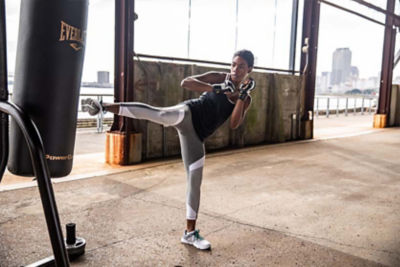How to Choose a Field Hockey Stick
Dominate the field with this guide to field hockey stick basics.

FIELD HOCKEY STICK MATERIALS
Wood field hockey sticks, traditionally made of hickory or mulberry, are mostly used by youth players for their lightweight feel and flexibility. Composite and fiberglass sticks are legal for play at the collegiate and high school levels. Experienced players use composite and fiberglass because it helps them generate more power on hits, without sacrificing flexibility and durability.
There are four different skill levels for sticks and each have a different composition, with each level increasing in composite and fiberglass material.
- Beginner sticks are perfect learning tools for first time players focusing on control and fundamental skills. They are recommended for players 10 years old or younger who have been playing for one year or less.
- Intermediate sticks continue to focus on control but introduce a key element of power to elevate your game. These are suggested for players 10-13 years old with 1-2 years of playing experience.
- Expert sticks offer an even balance of power and control, helping players continuously improve their skills. They are ideal for players 13+ years old with 2+ years of experience.
- Elite sticks are recommended for highly skilled players who desire power paired with precision. Typically boasting higher carbon content, Elite sticks are the most powerful. Recommended for players 15+ years old with 3+ years of experience.
STICK REINFOREMENTS
Reinforcements help your game in a variety of ways, from boosting your stick’s durability to enhancing its flexibility. Fiberglass reinforcements are taped to the side of the stick, applied as a sleeve to enhance strength and durability.
- Carbon fiber tape reinforcements are applied to both sides of the stick as a stiffening agent. This increases stiffness in the handle for more powerful hits.
- Kevlar tape is also applied as a reinforcement to enhance stiffness and minimize uncomfortable vibration on impact. Shock absorption helps maintain a smoother feel during play.
- Ceramic tape is an ultra-durable woven material that is sealed with high-strength glue. It wraps around the stick to reduce uncomfortable vibration.
TOE DESIGN
Use your position as a guideline for selecting a field hockey stick toe design. The toe is crafted for the ways different positions strike the ball. There are four basic kinds of toes in field hockey:
- Shorties are the most common and are usually used for offensive players. They help players quickly turn the stick over the ball and promote balance, maneuverability and control.
- Midis are popular and great for beginners and midfield players. They’re about a half-inch longer than shorties and provide a larger hitting surface. Flicking, receiving and reverse play are all easier with this design.
- Maxis are popular with defensive players. These toes combine a larger receiving area with the hitting power of a midi head. Hooks are J-shaped, with a larger stopping surface for receiving and defensive plays. They’re particularly well-suited for grass fields.
- Hooks have a J-shaped toe and are useful for covering for ground. They are made with a two-piece head, which can you have more control of the ball.
BOW DESIGN
The bow is the shape or the curve of the stick, or where it bends from the handle to the toe. There are three bow designs to choose from, depending on your preference, age and skill level:
- Regular bow is usually 20-22mm, with the most dramatic curve falling directly in the middle of the stick. It maximizes control and power, making it versatile for all field hockey positions.
- Control bow typically ranges from 22-23mm. The peak of the bend falls closer to the toe, aiding in power when lifting and drag flicking the ball. This type of bow is for more advanced players.
- Late bow measures around 24-25mm, and curves almost all the way toward the head. It offers the most help to elite players for controlling, lifting, drag flicking and performing aerials.
CHOOSING YOUR STICK LENGTH
You should always be able to comfortably control your field hockey stick. What size is right for you? Place the index finger of your right hand on your hipbone. Then place your middle and ring finger next to your index finger. The top of your stick should reach the side of your ring finger.
| PLAYER HEIGHT | STICK SIZE |
|---|---|
| 4 & UNDER | 28" |
| 4'1" - 4'3" | 30" |
| 4'4" - 4'6" | 32" |
| 4'7" - 5' | 34" |
| 5'1" - 5'3" | 35" - 35.5" |
| 5'4" - 5'9" | 36" - 36.5" |
| 5'10" & OVER | 37" - 37.5" |
CHOOSING YOUR STICK WEIGHT
Just like toe design, your stick weight should be based on position. Backs typically require a heavier stick of 22-24 ounces. The extra weight adds distance to hits and keeps your stick in play during attacks. Midfielders should choose an average-size stick of about 21 ounces to accommodate offensive and defensive plays. Forwards often go for a lightweight stick less than 21 ounces.
Most players carry at least two sticks for practice or play. If you switch positions, you may choose a stick for each position. Keep in mind, you’ll need to stock up on a variety of field hockey gear for your season, including cleats, shin guards and gloves.
Tip: Did you know there is no such thing as a left-handed field hockey stick? Field hockey requires all players to use a right-handed stick.
INDOOR FIELD HOCKEY STICKS
Indoor field hockey sticks are much thinner and lighter than outdoor field hockey sticks. Since the game is played on a smaller, flat and hard surface, there are rules that do not allow players to drive the ball or have a backswing. Thus, there is no need for such a sturdy stick.





